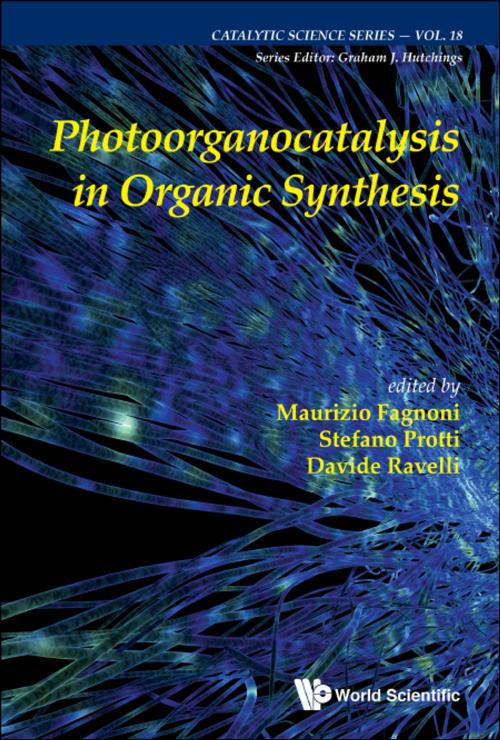Photoorganocatalysis in Organic Synthesis
Nonfiction, Science & Nature, Science, Chemistry, Physical & Theoretical, Organic| Author: | Maurizio Fagnoni, Stefano Protti, Davide Ravelli | ISBN: | 9781786346063 |
| Publisher: | World Scientific Publishing Company | Publication: | February 19, 2019 |
| Imprint: | WSPC (EUROPE) | Language: | English |
| Author: | Maurizio Fagnoni, Stefano Protti, Davide Ravelli |
| ISBN: | 9781786346063 |
| Publisher: | World Scientific Publishing Company |
| Publication: | February 19, 2019 |
| Imprint: | WSPC (EUROPE) |
| Language: | English |
The use of organocatalysts able to photocatalyze an organic reaction is a rapidly growing field. These photocatalyzed transformations are more environmentally sustainable with respect to the use of expensive/toxic metal-based (photo)catalysts.
Based on the authors' extensive experience in photogenerated intermediates, this book presents an overview on photocatalyzed organic processes having a synthetic significance, where an organic molecule functions as the photocatalyst.
After a brief introduction defining the nature and the characteristics of a photoorganocatalyst (POC), the chapters are organized according to the class of POC used, as detailed below.
Each chapter begins with a summary of the photophysical characteristics of the POCs and is followed by selected examples of synthetic applications. The last two chapters are devoted to the adoption of photoorganocatalysis in polymerization and to flow photoorganocatalysis. These in-depth explanations and practical applications make this title an essential reading for any chemistry student interested in organic (sustainable) synthesis.
Contents:
- Ketones and Aldehydes (Shin Kamijo)
- Quinones (Akichika Itoh)
- Aromatics and Cyanoaromatics (Stefano Protti and Davide Ravelli)
- Sulfur Heterocycles (Katarzyna Goliszewska, Katarzyna Orłowska and Dorota Gryko)
- Oxygen Heterocycles: Pyrylium Salts (Sergio M Bonesi and Al Postigo)
- Oxygen Heterocycles: Eosin Derivatives (Wen-Jing Xiao, Xiao-Qiang Hu, and Jia-Rong Chen)
- Oxygen Heterocycles: Fluorescein, Rhodamine, Rose Bengal (Daniele Leonori and Fabio Juliá)
- Nitrogen Heterocycles: Porphyrins (Hermenegildo García and Sonia Remiro-Buenamañana)
- Nitrogen Heterocycles: Acridinium Salts (Peter Fodran, Leticia Monjas and Carl-Johan Wallentin)
- Other Nitrogen Heterocycles: Carbazoles, Imides and PDI, mpg-C₃N₄, Tetrazines, Riboflavin, and BODIPY (Pier Giorgio Cozzi, Paola Ceroni, Andrea Gualandi, and Marianna Marchini)
- Photoorganocatalysts for Polymerization (Didier Gigmes, Frédéric Dumur, Nicolas Zivic, Ségolène Villotte, Jason C Morris, Jacques Lalevée and Aude Héloïse Bonardi)
- Photoorganocatalysis in Flow (Manuel Anselmo, Andrea Basso and Lisa Moni)
Readership: Any chemistry student interested in organic (sustainable) synthesis.
0
The use of organocatalysts able to photocatalyze an organic reaction is a rapidly growing field. These photocatalyzed transformations are more environmentally sustainable with respect to the use of expensive/toxic metal-based (photo)catalysts.
Based on the authors' extensive experience in photogenerated intermediates, this book presents an overview on photocatalyzed organic processes having a synthetic significance, where an organic molecule functions as the photocatalyst.
After a brief introduction defining the nature and the characteristics of a photoorganocatalyst (POC), the chapters are organized according to the class of POC used, as detailed below.
Each chapter begins with a summary of the photophysical characteristics of the POCs and is followed by selected examples of synthetic applications. The last two chapters are devoted to the adoption of photoorganocatalysis in polymerization and to flow photoorganocatalysis. These in-depth explanations and practical applications make this title an essential reading for any chemistry student interested in organic (sustainable) synthesis.
Contents:
- Ketones and Aldehydes (Shin Kamijo)
- Quinones (Akichika Itoh)
- Aromatics and Cyanoaromatics (Stefano Protti and Davide Ravelli)
- Sulfur Heterocycles (Katarzyna Goliszewska, Katarzyna Orłowska and Dorota Gryko)
- Oxygen Heterocycles: Pyrylium Salts (Sergio M Bonesi and Al Postigo)
- Oxygen Heterocycles: Eosin Derivatives (Wen-Jing Xiao, Xiao-Qiang Hu, and Jia-Rong Chen)
- Oxygen Heterocycles: Fluorescein, Rhodamine, Rose Bengal (Daniele Leonori and Fabio Juliá)
- Nitrogen Heterocycles: Porphyrins (Hermenegildo García and Sonia Remiro-Buenamañana)
- Nitrogen Heterocycles: Acridinium Salts (Peter Fodran, Leticia Monjas and Carl-Johan Wallentin)
- Other Nitrogen Heterocycles: Carbazoles, Imides and PDI, mpg-C₃N₄, Tetrazines, Riboflavin, and BODIPY (Pier Giorgio Cozzi, Paola Ceroni, Andrea Gualandi, and Marianna Marchini)
- Photoorganocatalysts for Polymerization (Didier Gigmes, Frédéric Dumur, Nicolas Zivic, Ségolène Villotte, Jason C Morris, Jacques Lalevée and Aude Héloïse Bonardi)
- Photoorganocatalysis in Flow (Manuel Anselmo, Andrea Basso and Lisa Moni)
Readership: Any chemistry student interested in organic (sustainable) synthesis.
0















